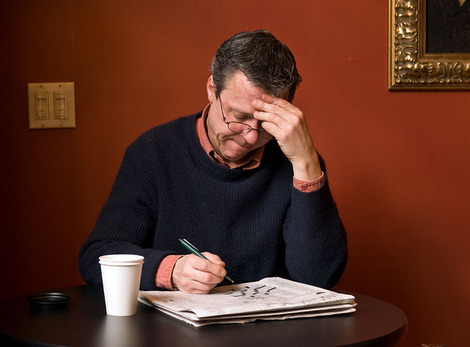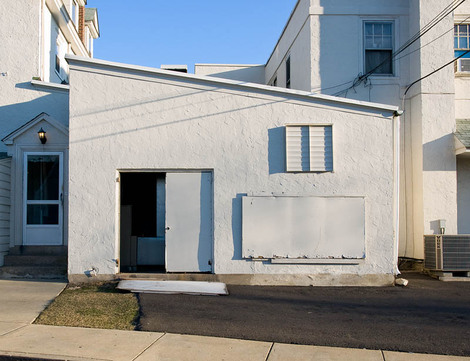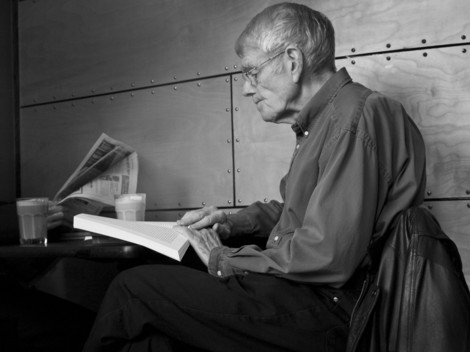By Gordon Lewis
In the previous two installments I explained why I decided to get an Olympus E-510 and how I figured out how get reliable and consistent results from its meter. And once again, just so there’s no misunderstanding, the E-510’s meter is no less reliable or consistent than any other. You just need to take the time to understand how it works, the same as you (hopefully) would with any other camera.
My primary reasons for buying the E-510 were its portability, flexibility, in-body image stabilization (IS), and the availability of high-quality, compact, reasonably fast, yet reasonably priced lenses in the range I wanted. My only lens so far is the 14–54mm ƒ/2.8–3.5 Zuiko, which will soon be followed by the 40–150mm ƒ/3.5–4.5 Zuiko. I’ve been shooting for over 30 years, so I know exactly what I need to get the types of photos I like to shoot, which include travel, architecture, street scenes, candids, portraits, and abstracts. Needless to say, your needs may differ.
My normal photo routine while vacationing in London consisted of day trips with my camera in a small (10” x 6” x 4.5”) Domke F-5XB
shoulder bag. The only accessories I carried were a second Compact
Flash card and battery. I had no hesitation about slinging the bag over
my shoulder and carrying it with me everywhere I went. Aside from brief
subway or bus rides, I walked from place to place. The E-510 never
became a burden or an impediment; in fact, the E-510 is one of the best
handling, most comfortable cameras I’ve ever owned.

This gentleman was seated next to a large window. Even so, the exposure
was 1/30 second at f/4.0 at ISO 400. I was zoomed to 45mm (90mm
equivalent for 35mm format), which is close to the maximum focal
length, and I was at maximum aperture. The E-510's image stabilization
helped steady the shot. As you can see from the 100% enlargement below,
the E-510 can deliver excellent results handheld at ISO 400. Another
bonus is that I was only about six feet away in a quiet coffee shop and
he never noticed the sound of my camera.

This is a crop of the above photo enlarged to
100%. The camera's noise reduction feature was turned off. I find this
improves image detail with minimal sacrifice of noise. Above ISO 800,
noise becomes more obvious; however, it's mostly luminance noise and
therefore more "film-like."
-
Once I got used to the single display on the back, I liked the fact that I could tell at a glance what ISO the camera was set to, whether IS was on or off, what shutter speed, aperture, and exposure compensation I had set, and so on. Changing settings was no slower than with other DSLRs I’ve used, and in some cases faster. The display was bright enough to be usable in daylight, even when using the Live View feature. Glare and reflections can be a problem at times, but all essential information is visible through the viewfinder.
The situation where I most often noticed the E-510 reaching the limits of its abilities was in low light (EV 5 or below). Autofocus speed slowed noticeably and its accuracy became less consistent. Because the E-510’s viewfinder magnification is low (0.92X), accurate manual focusing was next to impossible. In theory, it would have been possible to switch to Live View mode and to magnify the image up to 10X. In reality, this was practical only when the camera was mounted on a tripod.
As for the IS feature, I didn’t expect any miracles nor did I witness any, but it definitely reduced hand-shake with borderline shutter speeds such as 1/60 or 1/30. Lower than that, subject motion and low-light focusing errors conspired to make the results hit-or-miss.

With proper exposure and with the recording mode set to RAW, the E-510
can handle highlights quite well. There's even enough dynamic range
(and low enough lens flare) to see inside the door in the foreground.
-
If you judge image quality based on how well a camera does at ISO 3200 and print sizes of 30 x 40" (the E-510 is a Four-Thirds camera, remember) then you will find the Olympus E-510 a disappointment. Keep saving up for that Canon 5D, Canon 1DS Mark III, or Nikon D3. If, on the other hand, you can live with smaller print sizes and with ISO 800 as your practical limit, the E-510 will often surprise and delight. I was shooting with the 14–54mm Zuiko, and found its resolution, micro-contrast, tonality, and flare resistance outstanding. Linear distortion was remarkably low at all focal lengths. Bokeh was buttery smooth. The images required minimal sharpening. Frankly, I think this camera is worth considering for the quality of the lens alone.

This photo was a test of the E-510's Live View feature. I exposed it at 1/60 second at ƒ/4 at ISO 400, with IS on and with the camera resting on my knee. Using Live View results in a one-second shutter lag, but in this case the subject wasn't moving and neither was I, so it wasn't a problem. I converted the image to black and white in Photoshop and sharpened it a bit, but the resolution, tonality and bokeh are all typical of what the E-510 and 14–54mm ƒ/2.8–3.5 Zuiko can do.
-
There are a few negatives, of course: The viewfinder is small, low-light focus is dodgy, and the default image settings are sub-optimal; but if you’re looking for a small but full-featured DSLR that can produced professional quality results, the Olympus E-510 should be on your short list.
_____________________
Gordon



Gordon, thank you for doing this review. While I have my own preference in a digital camera (Pentax), I have found this to be very informative. I wish that someone of your experience would do these kind of real world reviews for all of the major DSLR's. This is much more interesting than Pixel peeping and techno schmoozing. It sounds like a great camera and lens system. Please update us on occasion as you use it.
Posted by: Brian White | Wednesday, 20 February 2008 at 11:45 AM
I go with Brian White here.
Those 3 Parts were a joy to read, and hopefully there is more coming, Gordon.
I have a E-1 and the 14-54. For most things I use a Pentax K10D now, but I am unable to part with the E-1. Interestingly, every time I consider selling it, the lens shows up in my mind and evokes a kinda warm feeling. I also thought about selling only the E-1 and getting a 510, only to be able to continue using this lens. I love it, and there is nothing from other manufacturers like that. Either too short, or too slow or to big, or too heavy... hideous bokeh for most zooms not to mention.
On the other hand, you rarely get bokeh from a 4/3 system in the "normal" focal length range. And with the 510 you miss the pleasure of getting connected with the subject through the viewfinder. The viewfinder is the sensual part of a camera, imho. We know how disappointing the 510's is. And then there are no primes to the street shooter's liking. And the 25 1.4 kills the size appeal of the 510.
So again, nothing's perfect. But I stop moaning and just hope for more to come...
from Oly...
from Pentax...
and from you, Gordon...
best always
Andreas
Posted by: Andreas | Wednesday, 20 February 2008 at 04:46 PM
Nice well balanced review Gordon. As someone with absolutely no brand loyalty whatsoever (I'll use anything that does the job) I have to say since switching to Olympus recently I couldn't be happier. The size and handling are really exceptional, especially the tiny E410 which is a complete gem.
As an added bonus anyone brought up on MF and LF may get on well with the 4:3 frame. Also on the same subject its actually quite possible to step back and use live view as a substitute ground glass.
Posted by: Neil | Wednesday, 20 February 2008 at 05:32 PM
Thanks for the review. Wish most of them were as illustrative, well written and pleasurable to read.
I have a dumb question for Mike.
I must confess I am still doing a lot of "analog" photography, but getting used to digital. I do a lot of street photography, and since the DMD camera is nowhere near, I am considering buying a DSLR. I want to be discreet, don't like the mirror slamming shutter cringing noises of the SLRs. Since I rarely look trough the viewfinder(I frame by instinct) and only use one lens (28 mm.), could I have the mirror removed? Is there a small, unobtrusive DSLR with "permanent" mirror lock up?
I was dreaming of this scheme where 2.000 of us sent 100 emails a day to Pentax suggesting they make a RF digicam out of the dyes of the discontinued K10 (chop the mirror and pentaprism assembly, add a live view screen), but I guess it just would not work...
Posted by: jg | Wednesday, 20 February 2008 at 06:17 PM
I've decided I can't live with my 510. The metering is difficult, I'm finding myself metering off the sky or spot metering neutral grays tring to find a balance. That's ok for the slow stuff but shooting quick with a modern DSLR demands accurate matrix/evaluative metering. Also the highlight clipping/tone curve of the 510 is just not acceptable. Folks can tell me otherwise but I've shot enough with other cameras to know this is true. I photographed an old truck the other day and exposed to keep the highlights in check. Just to the point of blinking highlights. The shadow areas when opened up in Photoshop displayed a noise level that was near shocking. Looked like 1600 B&W film. I've tried all the recommended settings, shooting raw and the like. It's really a shame because it is an otherwise a nifty camera with some cool features but in the end I think the 4/3's system is destined for hard times. That little sensor and Oly's processing engine can't really compete with the big boys. Sorry I've tried hard to like it and it's just not going to work. Gonna cost me some $$ but I'd rather switch than fight.
Posted by: Emm Jay | Thursday, 21 February 2008 at 12:32 AM
Without knowing the ISO value used, a statement like QUOTE in low light (EV 5 or below) UNQUOTE contains no information.
This is because the EV will change, with the light unchanged, if you change the ISO value to which you have set your meter.
Regards,
Chris
Posted by: Christer Almqvist | Thursday, 21 February 2008 at 06:27 AM
It seems that everyone really WANTS olympus to work and will put up with more ways to work around its deficiencies that would simply not be tolerated if it was made by brands C or N.
I don't get it... too much noise, slow AF, bad meter, worse dynamic range, tiny finder, but you do persist. It's nice that Oly is trying, but they keep missing the mark by a wide margin.
A small sensor has tremendous technical limitations, that's all there is to it. I'd be surprised if 4/3 was around in another 5 years.
Posted by: mike | Thursday, 21 February 2008 at 10:11 AM
Chris is right about EV. My apologies. When I referred to EV 5, I meant at ISO 100, which would be equivalent to an exposure of 1/4 second at f/2.8 (or 1/8 second at f/2.0, 1/15 second at f/1.4, etc.). The same amount of light at ISO 400 would require an exposure of 1/15 second at f/2.8 (or the equivalent).
Some may not regard this as particularly low light, but keep in mind that many of today's photographers are shooting with kit lenses that have a maximum aperture of f/4.5 or f/5.6. This reduces the amount of light the AF system has to work with, as well as the maximum shutter speed for an equivalent exposure. At ISO 400, for example, EV 5 would require an exposure of 1/4 second at f/5.6.
The main point here is that the E-510's focusing speed slows noticeably at moderately low light levels. Even though it may lock focus (audible beep and focus confirmation light on), the point of focus is not necessarily accurate, and because the viewfinder magnification is so low it's practically impossible to confirm focus with the naked eye.
Posted by: Gordon Lewis | Thursday, 21 February 2008 at 10:16 AM
"I don't get it... too much noise, slow AF, bad meter, worse dynamic range, tiny finder, but you do persist. It's nice that Oly is trying, but they keep missing the mark by a wide margin. A small sensor has tremendous technical limitations, that's all there is to it."
I think everything you've said here is consensus myth, forum wisdom. There's no effective difference between 4/3rds and APS-C, or indeed any sensor sizes within about 1.5X of each other. The distinctions are incremental, masked by implementation issues, and invisible to viewers in either prints or online pictures.
Conclusions like this are the result of excessive theorizing and what might be called mass prejudice, where a community of people agree on values arbitrarily. It's doctrine, not practical fact.
Mike J.
Posted by: Mike Johnston | Thursday, 21 February 2008 at 10:58 AM
"I don't get it... too much noise, slow AF, bad meter, worse dynamic range, tiny finder, but you do persist. It's nice that Oly is trying, but they keep missing the mark by a wide margin. A small sensor has tremendous technical limitations, that's all there is to it."
The Olympus E-510 does have its faults, which I have mentioned and which the writer has exaggerated, but there's no such thing as a perfect camera, even from Canon and Nikon. I've been shooting for over 30 years and have yet to find one.
Keep in mind that I also own a Canon EOS 30D and several Canon lenses. The 30D is a wonderful camera and a pleasure to use, but it, too, has what I consider faults, some of which I noted in Part 1 of my review.
If the Olympus E-510 or any other camera doesn't float your boat, fine; nobody's forcing you to use it. I would humbly suggest, however, that unless you've used it yourself, you really don't know much about it, and that you should be more reticent about offering uninformed opinions.
Posted by: Gordon Lewis | Thursday, 21 February 2008 at 11:44 AM
'I think everything you've said here is consensus myth, forum wisdom. There's no effective difference between 4/3rds and APS-C, or indeed any sensor sizes within about 1.5X of each other. The distinctions are incremental, masked by implementation issues, and invisible to viewers in either prints or online pictures.'
Absolutely true - the only technical weakness I've found after thousands of frames with Olympus is that the 3 point focusing works perfectly well, but is a bit less effective in some circumstances than more sophisticated systems and the in camera JPEGs could be better.
Posted by: Neil | Thursday, 21 February 2008 at 12:24 PM
Gordon, just one comment - I think you were further away than 6 feet (quite a bit further away, in fact!). At 90mm, if you were only 6 feet away, the full frame photo would look a lot more like your crop. To my eye, it looks like you were about twice as far away, roughly, maybe more.
Posted by: Rudi | Thursday, 21 February 2008 at 10:37 PM
"It seems that everyone really WANTS olympus to work and will put up with more ways to work around its deficiencies that would simply not be tolerated if it was made by brands C or N."
Mike nailed it. As a long time N owner I can assure you something like the D80 is a far easier camera to land well exposed photos with. I'm grateful to Oly cause it's forced me to sell off everything I own to buy a Canon 5D and 24-105 IS. The big retailers are selling this as a combo for $2750.
Posted by: Emm Jay | Thursday, 21 February 2008 at 11:02 PM
>> "It seems that everyone really WANTS olympus to work and will put up with more ways to work around its deficiencies that would simply not be tolerated if it was made by brands C or N."
Mike nailed it. As a long time N owner I can assure you something like the D80 is a far easier camera to land well exposed photos with. I'm grateful to Oly cause it's forced me to sell off everything I own to buy a Canon 5D and 24-105 IS. The big retailers are selling this as a combo for $2750. <<
Olympus really works for me and others... The problem is what you want from your dSLR (and from lenses!) and, obviously, how much do you want to pay for it (E-510 vs 5D??!!).
However, I'm ok with my E-500 and, instead of upgrading to E-510 for IS, I took a lightweight (0,4 kg), strong (it can take 4,5 kg) and cheap (€ 35) Manfrotto monopod.
Posted by: Milo Di Mattia | Friday, 22 February 2008 at 05:13 AM
"A small sensor has tremendous technical limitations, that's all there is to it. I'd be surprised if 4/3 was around in another 5 years."
When the 4/3 system was first launch we hear comment like these from the press, camera review website, etc.
5 years later, now we still hear comment like that but only in forum and blog comments post.
Nevertheless the 4/3, is still around and gaining users and support from more manufacturers, and those are no small time camera makers too.
Even many camera review website that was once critical of the 4/3 are having softer tone now toward 4/3 system.
Infact many of the arguments that was initially put up by Kodak and Oly on 4/3 are now seem appearing on non 4/3 cameras.
As digital electronic and chip technology progress. The only direction is moving to smaller and smaller chips, sensor are no different is just a matter of time we will see professional SLR using smaller chip than 4/3.
15 years from now 4/3, APS and fullframe sensor will be obsolete just like film and replace by something even smaller.
Posted by: John Ono | Friday, 22 February 2008 at 05:39 AM
I agree with Mr Lewis that some Zuiko Digital lenses are enough reason in themselves to buy into the FourThirds system, and that the 14-54mm f/2.8-3.5 is one of them. I've got this lens and use it on the E-1. I agree that its strongest selling point is the almost complete absence of linear distortions, something quite possibly unprecedented on other standard zooms, of any system.
Coupled with a sealed body such as the E-1 or the E-3, the 14-54mm lens can also take advantage of its weather sealing. Not bad for a sub-$400 piece of glass, is it?
Other candidates for a lens that may make the switch to FourThirds sensible on its own include the ED 7-14mm f/4, which is an ultrawide zoom in the same league as the new Zoom-Nikkor 14-24mm f/2.8, the ED 50-200mm f/2.8-3.5 SWD, which is a fast telezoom covering the angle-of-view range of a 100-400mm lens for the 135 format, and the ED 40-150mm f/4-5.6, which is quite simply the lightest most compact 80-300mm equivalent lens ever made for any SLR system.
Posted by: Zoltan | Friday, 22 February 2008 at 06:50 AM
People moaning about E-510 in camera JPEGs lack of DR have to realise, it is set-up with a consumer colours (tone curve) out of the box. Oly reason the more seasoned SLR users will be able to dial in the setting that best suit their taste. Try the Muted setting with minus 2 on the contrast and sharpness; noise filter off and your so called DR issues are history. Take the AF point out of the equation (through the menus)when the shutter release button is fully depressed and focus recompose will work identically to any other SLR. As with every camera, it's a learning tool, so learn how to expose correctly...
Posted by: Haider Gill | Saturday, 23 February 2008 at 07:37 AM
It cracks me up how many people love to hate Olympus. I'll be honest and say I shot with a OM-2n for 20 years (yikes) and waited for the DSLR designs and pricing to level out before I bought in. I was shooting EOS film at the time and loving it except for the size (Elan IIe). When the digital Rebel came out I was enamored but still couldn't reach it price wise. As I waited and Olympus came out with the E-1, I could see the writing on the wall. I don't baby my cameras, (when I travel its usually on the floorboards at my feet-no bag-no cover). So dust for me is a real issue. And I never did like the printed results of the lower end EOSs. And I liked that all the reports of the Oly said film like grain, great colors and best of all great jpgs. Just what the doctor ordered. I still had to wait for the pricing to reach my level. I now shoot with an E-500. Oh yeah and the reports of the sharp as a tack kit lenses, its true. Oly gives kit lenses a good name. My one compromise - no vertical grip option.
Posted by: vbsoto | Saturday, 23 February 2008 at 09:13 AM
As an old timer and musician, I hear the same banter from many young folks not really doing their homework on quite a few various forums and subjects.
I was a professional photographer for several years and even though they were not digital, the Hasselblad and pentax 6x7 outfits I used were fantastic and I see the same type of quality in the E Systems from Olympus and I must say it is quite amazing.
As for the musician part I hear the same arguments in analog vs. digital synthesis and I have come to the conclusion that most of these people are just being too picky and are so caught up in the technology they have lost the ability to be artists if they really ever had that ability to begin with.
Posted by: KB | Saturday, 10 May 2008 at 06:13 AM